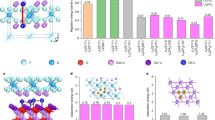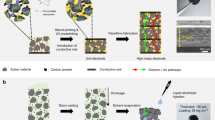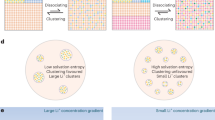Abstract
Electrolyte engineering breakthroughs are crucial to support extremely high-energy battery chemistries. However, the complex interplay between battery performance and electrolyte structure remains poorly understood and difficult to predict. Here we introduce the concept of ‘normalized cation/anion–solvent affinity’, which describes the critical interactions between solvents and both cations and anions. This innovative approach allows for the simultaneous and quantitative prediction of electrolyte microstructures, transport characteristics, redox behaviours and interphase characteristics. Leveraging this framework, we screened approximately 150 solvent candidates and identified electrolyte formulations that significantly improve Li metal plating/stripping Coulombic efficiency ( >99.5%). Among these, four electrolytes achieved Coulombic efficiency greater than 99.8%, while supporting the durability of aggressive high-voltage cathodes. These formulations enabled the realization of highly reversible Li metal batteries (LMBs) with a record-breaking high energy density of 600 Wh kg−1 and over 100 cycles, advancing LMBs towards practical applications. The unified affinity paradigm offers valuable insights for designing next-generation electrolytes for high-energy LMBs and other alkali-metal-ion batteries.
This is a preview of subscription content, access via your institution
Access options
Access Nature and 54 other Nature Portfolio journals
Get Nature+, our best-value online-access subscription
$32.99 / 30 days
cancel any time
Subscribe to this journal
Receive 12 digital issues and online access to articles
$119.00 per year
only $9.92 per issue
Buy this article
- Purchase on SpringerLink
- Instant access to full article PDF
Prices may be subject to local taxes which are calculated during checkout





Similar content being viewed by others
Data availability
All data supporting the conclusions of this study are provided within the main article and its Supplementary Information files. Source data are provided with this paper.
References
Armand, M. & Tarascon, J. M. Building better batteries. Nature 451, 652–657 (2008).
Meng, Y. S., Srinivasan, V. & Xu, K. Designing better electrolytes. Science 378, eabq3750 (2022).
Xu, K. Nonaqueous liquid electrolytes for lithium-based rechargeable batteries. Chem. Rev. 104, 4303–4417 (2004).
Louli, A. J. et al. Diagnosing and correcting anode-free cell failure via electrolyte and morphological analysis. Nat. Energy 5, 693–702 (2020).
Yao, N., Chen, X., Fu, Z.-H. & Zhang, Q. Applying classical, ab initio, and machine-learning molecular dynamics simulations to the liquid electrolyte for rechargeable batteries. Chem. Rev. 122, 10970–11021 (2022).
Wang, H. et al. Liquid electrolyte: the nexus of practical lithium metal batteries. Joule 6, 588–616 (2022).
Rustomji, C. S. et al. Liquefied gas electrolytes for electrochemical energy storage devices. Science 356, eaal4263 (2017).
Zhang, Z. et al. Capturing the swelling of solid-electrolyte interphase in lithium metal batteries. Science 375, 66–70 (2022).
Niu, C. et al. High-energy lithium metal pouch cells with limited anode swelling and long stable cycles. Nat. Energy 4, 551–559 (2019).
Xue, W. J. et al. Ultra-high-voltage Ni-rich layered cathodes in practical Li metal batteries enabled by a sulfonamide-based electrolyte. Nat. Energy 6, 495–505 (2021).
Yu, Z. et al. Molecular design for electrolyte solvents enabling energy-dense and long-cycling lithium metal batteries. Nat. Energy 5, 526–533 (2020).
Wu, L.-Q. et al. Unveiling the role of fluorination in hexacyclic coordinated ether electrolytes for high-voltage lithium metal batteries. J. Am. Chem. Soc. 146, 5964–5976 (2024).
Zhang, H. et al. Cyclopentylmethyl ether, a non-fluorinated, weakly solvating and wide temperature solvent for high-performance lithium metal battery. Angew. Chem. Int. Ed. 62, e202300771 (2023).
Holoubek, J. et al. Tailoring electrolyte solvation for Li metal batteries cycled at ultra-low temperature. Nat. Energy 6, 303–313 (2021).
Yao, Y.-X. et al. Regulating interfacial chemistry in lithium-ion batteries by a weakly solvating electrolyte. Angew. Chem. Int. Ed. 60, 4090–4097 (2021).
Wu, Z. C. et al. Deciphering and modulating energetics of solvation structure enables aggressive high-voltage chemistry of Li metal batteries. Chem 9, 650–664 (2023).
Chen, S. R. et al. High-voltage lithium-metal batteries enabled by localized high-concentration electrolytes. Adv. Mater. 30, 1706102 (2018).
Ren, X. et al. Enabling high-voltage lithium-metal batteries under practical conditions. Joule 3, 1662–1676 (2019).
Zheng, J. et al. Electrolyte additive enabled fast charging and stable cycling lithium metal batteries. Nat. Energy 2, 17012 (2017).
Zhang, H. et al. Electrolyte additives for lithium metal anodes and rechargeable lithium metal batteries: progress and perspectives. Angew. Chem. Int. Ed. 57, 15002–15027 (2018).
Wang, Y. et al. Emerging electrolytes with fluorinated solvents for rechargeable lithium-based batteries. Chem. Soc. Rev. 52, 2713–2763 (2023).
Tan, J., Matz, J., Dong, P., Shen, J. & Ye, M. A growing appreciation for the role of LiF in the solid electrolyte interphase. Adv. Energy Mater. 11, 2100046 (2021).
Wang, Z. et al. Insights into the deposition chemistry of Li ions in nonaqueous electrolyte for stable Li anodes. Chem. Soc. Rev. 50, 3178–3210 (2021).
Liu, Y. et al. Self-assembled monolayers direct a LiF-rich interphase toward long-life lithium metal batteries. Science 375, 739–745 (2022).
Cheng, H. et al. Emerging era of electrolyte solvation structure and interfacial model in batteries. ACS Energy Lett. 7, 490–513 (2022).
Su, C.-C. et al. Solvating power series of electrolyte solvents for lithium batteries. Energy Environ. Sci. 12, 1249–1254 (2019).
Efaw, C. M. et al. Localized high-concentration electrolytes get more localized through micelle-like structures. Nat. Mater. 22, 1531–1539 (2023).
Seo, D. M. et al. Electrolyte solvation and ionic association I. acetonitrile-lithium salt mixtures: intermediate and highly associated salts. J. Electrochem. Soc. 159, A553–A565 (2012).
Yu, Z. et al. Beyond local solvation structure: nanometric aggregates in battery electrolytes and their effect on electrolyte properties. ACS Energy Lett. 7, 461–470 (2022).
Fadel, E. R. et al. Role of solvent-anion charge transfer in oxidative degradation of battery electrolytes. Nat. Commun. 10, 3360 (2019).
Liu, Y., Sengupta, A., Raghavachari, K. & Flood, A. H. Anion binding in solution: beyond the electrostatic regime. Chem 3, 411–427 (2017).
Chen, X. & Zhang, Q. Atomic insights into the fundamental interactions in lithium battery electrolytes. Acc. Chem. Res. 53, 1992–2002 (2020).
Ko, S. et al. Electrode potential influences the reversibility of lithium-metal anodes. Nat. Energy 7, 1217–1224 (2022).
Hobold, G. M. et al. Moving beyond 99.9% Coulombic efficiency for lithium anodes in liquid electrolytes. Nat. Energy 6, 951–960 (2021).
Fan, X. L. et al. Non-flammable electrolyte enables Li-metal batteries with aggressive cathode chemistries. Nat. Nanotechnol. 13, 715–722 (2018).
Fang, C., Mistry, A., Srinivasan, V., Balsara, N. P. & Wang, R. Elucidating the molecular origins of the transference number in battery electrolytes using computer simulations. JACS Au 3, 306–315 (2023).
Suo, L., Hu, Y.-S., Li, H., Armand, M. & Chen, L. A new class of solvent-in-salt electrolyte for high-energy rechargeable metallic lithium batteries. Nat. Commun. 4, 1481 (2013).
Bergstrom, H. K. & McCloskey, B. D. Ion transport in (localized) high concentration electrolytes for Li-based batteries. ACS Energy Lett. 9, 373–380 (2024).
Zhang, Y., Bier, I. & Viswanathan, V. Predicting electrolyte conductivity directly from molecular-level interactions. ACS Energy Lett. 7, 4061–4070 (2022).
Chen, M., Zhang, J., Ji, X., Fu, J. & Feng, G. Progress on predicting the electrochemical stability window of electrolytes. Curr. Opin. Electrochem. 34, 101030 (2022).
Peljo, P. & Girault, H. H. Electrochemical potential window of battery electrolytes: the HOMO–LUMO misconception. Energy Environ. Sci. 11, 2306–2309 (2018).
Lin, S. et al. Reclaiming neglected compounds as promising solid state electrolytes by predicting electrochemical stability window with dynamically determined decomposition pathway. Adv. Energy Mater. 12, 2201808 (2022).
Wang, J. et al. Superconcentrated electrolytes for a high-voltage lithium-ion battery. Nat. Commun. 7, 12032 (2016).
Borodin, O. & Smith, G. D. Quantum chemistry and molecular dynamics simulation study of dimethyl carbonate: ethylene carbonate electrolytes doped with LiPF6. J. Phys. Chem. B 113, 1763–1776 (2009).
Adams, B. D., Zheng, J., Ren, X., Xu, W. & Zhang, J.-G. Accurate determination of Coulombic efficiency for lithium metal anodes and lithium metal batteries. Adv. Energy Mater. 8, 1702097 (2018).
Kim, S. C. et al. High-entropy electrolytes for practical lithium metal batteries. Nat. Energy 8, 814–826 (2023).
Moon, J. et al. Non-fluorinated non-solvating cosolvent enabling superior performance of lithium metal negative electrode battery. Nat. Commun. 13, 4538 (2022).
Yu, Z. et al. Rational solvent molecule tuning for high-performance lithium metal battery electrolytes. Nat. Energy 7, 94–106 (2022).
Huang, Y. et al. Eco-friendly electrolytes via a robust bond design for high-energy Li metal batteries. Energy Environ. Sci. 15, 4349–4361 (2022).
Zhang, Q.-K. et al. Homogeneous and mechanically stable solid–electrolyte interphase enabled by trioxane-modulated electrolytes for lithium metal batteries. Nat. Energy 8, 725–735 (2023).
Galvez-Aranda, D. E. & Seminario, J. M. Li-metal anode in dilute electrolyte LiFSI/TMP: electrochemical stability using ab initio molecular dynamics. J. Phys. Chem. C 124, 21919–21934 (2020).
Borodin, O., Behl, W. & Jow, T. R. Oxidative stability and initial decomposition reactions of carbonate, sulfone, and alkyl phosphate-based electrolytes. J. Phys. Chem. C 117, 8661–8682 (2013).
Kaminski, G. A., Friesner, R. A., Tirado-Rives, J. & Jorgensen, W. L. Evaluation and reparametrization of the OPLS-AA force field for proteins via comparison with accurate quantum chemical calculations on peptides. J. Phys. Chem. B 105, 6474–6487 (2001).
Dodda, L. S., Cabeza de Vaca, I., Tirado-Rives, J. & Jorgensen, W. L. LigParGen web server: an automatic OPLS-AA parameter generator for organic ligands. Nucleic Acids Res. 45, W331–W336 (2017).
Jewett, A. I. et al. Moltemplate: a tool for coarse-grained modeling of complex biological matter and soft condensed matter physics. J. Mol. Biol. 433, 166841 (2021).
Martínez, L., Andrade, R., Birgin, E. G. & Martínez, J. M. PACKMOL: a package for building initial configurations for molecular dynamics simulations. J. Comput. Chem. 30, 2157–2164 (2009).
VandeVondele, J. et al. Quickstep: fast and accurate density functional calculations using a mixed Gaussian and plane waves approach. Comput. Phys. Commun. 167, 103–128 (2005).
Jie, Y. et al. Towards long-life 500 Wh kg−1 lithium metal pouch cells via compact ion-pair aggregate electrolytes. Nat. Energy https://doi.org/10.1038/s41560-024-01565-z (2024).
Kwon, H. et al. Borate–pyran lean electrolyte-based Li-metal batteries with minimal Li corrosion. Nat. Energy 9, 57–69 (2024).
Mao, M. et al. Anion-enrichment interface enables high-voltage anode-free lithium metal batteries. Nat. Commun. 14, 1082 (2023).
Xia, Y. et al. Designing an asymmetric ether-like lithium salt to enable fast-cycling high-energy lithium metal batteries. Nat. Energy 8, 934–945 (2023).
Zhang, Y. et al. Enabling 420 Wh kg−1stable lithium-metal pouch cells by lanthanum doping. Adv. Mater. 35, 2211032 (2023).
Gao, Y. et al. Effect of the supergravity on the formation and cycle life of non-aqueous lithium metal batteries. Nat. Commun. 13, 5 (2022).
Shi, P. et al. Inhibiting intercrystalline reactions of anode with electrolytes for long-cycling lithium batteries. Sci. Adv. 8, eabq3445 (2022).
Niu, C. et al. Balancing interfacial reactions to achieve long cycle life in high-energy lithium metal batteries. Nat. Energy 6, 723–732 (2021).
Qiao, Y. et al. A high-energy-density and long-life initial-anode-free lithium battery enabled by a Li2O sacrificial agent. Nat. Energy 6, 653–662 (2021).
Acknowledgements
This work was supported by the National Key Research and Development Program of China (2024YFB3814300), Natural Science Foundation of Zhejiang Province (LR23B030002), National Natural Science Foundation of China (22409176 and U21A2081), Fundamental Research Funds for the Central Universities (226-2024-00075) and ‘Hundred Talents Program’ of Zhejiang University.
Author information
Authors and Affiliations
Contributions
R.L. and X.F. conceived the idea and designed the experiments. R.L. and H.Z. provided the theoretical simulations. R.L., H.Z., S.Z. and J.Z. conducted the electrochemical experiments and characterizations. Long Chen, X.X., Lixin Chen, Y.S. and T.D. participated in the scientific discussion and data analysis. Y.L., R.G., M.Y. and H.P. carried out the electrochemical test of pouch cells. R.L. and X.F. prepared the manuscript with the input of all the co-authors. All authors endorsed the final version of the manuscript.
Corresponding author
Ethics declarations
Competing interests
The authors declare no competing interests.
Peer review
Peer review information
Nature Energy thanks Lynden Archer and the other, anonymous, reviewers for their contribution to the peer review of this work.
Additional information
Publisher’s note Springer Nature remains neutral with regard to jurisdictional claims in published maps and institutional affiliations.
Supplementary information
Supplementary Information
Supplementary Figs. 1–55, discussion and Tables 1–9.
Source data
Source Data Fig. 1
Source data Fig. 1.
Source Data Fig. 2
Source data Fig. 2.
Source Data Fig. 3
Source data Fig. 3.
Source Data Fig. 4
Source data Fig. 4.
Source Data Fig. 5
Source data Fig. 5.
Rights and permissions
Springer Nature or its licensor (e.g. a society or other partner) holds exclusive rights to this article under a publishing agreement with the author(s) or other rightsholder(s); author self-archiving of the accepted manuscript version of this article is solely governed by the terms of such publishing agreement and applicable law.
About this article
Cite this article
Li, R., Zhang, H., Zhang, S. et al. Unified affinity paradigm for the rational design of high-efficiency lithium metal electrolytes. Nat Energy 10, 1155–1165 (2025). https://doi.org/10.1038/s41560-025-01842-5
Received:
Accepted:
Published:
Issue date:
DOI: https://doi.org/10.1038/s41560-025-01842-5



